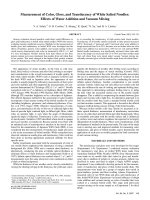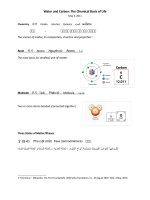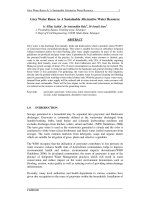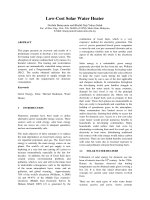Minerals (cont) water
Bạn đang xem bản rút gọn của tài liệu. Xem và tải ngay bản đầy đủ của tài liệu tại đây (771.6 KB, 33 trang )
The Trace Minerals
Copyright 2005 Wadsworth Group, a division of Thomson Learning
The Trace Minerals
Copyright 2005 Wadsworth Group, a division of Thomson Learning
Trace Minerals
Iron
Iodine
Fluoride
Manganese
Molybdenum
Nickel
Boron
Zinc
Selenium
Copper
Chromium
Arsenic
Silicon
Cobalt
Iron
• Ferrous (Fe++)
– Reduced
• Ferric (Fe+++)
– Oxidized
• Chief functions in the body
– Part of the protein hemoglobin, which carries
oxygen in the blood
– Part of the protein myoglobin in muscles,
which makes oxygen available for muscle
contraction
– Necessary for the utilization of energy as part
of the cells’ metabolic machinery
Copyright 2005 Wadsworth Group, a division of Thomson Learning
Iron Absorption
Copyright 2005 Wadsworth Group, a division of Thomson Learning
Iron
Sources – two forms of iron in food
1. Heme iron – meats, poultry,
fish; readily absorbed
2. Nonheme iron – plants foods;
less absorbed
a. Absorption enhanced by
Vitamin C
b. Absorption diminished by
phytates, oxalates, and
tannic acid
Iron: Heme vs. Nonheme
Copyright 2005 Wadsworth Group, a division of Thomson Learning
Iron
• 2001 RDA
– Men: 8 mg/day
– Women (19-50 years): 18 mg/day
– Women (51+ years): 8 mg/day
• Upper level for adults: 45 mg/day
• Significant sources
– Red meats, fish, poultry, shellfish, eggs
– Legumes, dried fruits
Copyright 2005 Wadsworth Group, a division of Thomson Learning
Iron
• Iron deficiency is the most common
nutrient deficiency worldwide
• Can occur if inadequate intake or blood
loss
• Females are prone due to menstruation,
lower iron intake & pregnancy
• Preschoolers also at risk due to high milk
diets
Copyright 2005 Wadsworth Group, a division of Thomson Learning
Iron
• Deficiency symptoms
– Microcytic, hypochromic anemia (low Hgb &
Hct): weakness, fatigue, headaches
– Impaired work performance and cognitive
function
– Impaired immunity
– Pale skin, nailbeds, mucous membranes,
and palm creases
– Concave nails
– Inability to regulate body temperature
– Pica (craving for ice, clay, paste, and other
non-food substances)
Copyright 2005 Wadsworth Group, a division of Thomson Learning
• Both size and color
are normal in
these blood cells
• Blood cells in irondeficiency anemia
are small and pale
because they
contain less
hemoglobin
Iron
• Toxicity – “iron overload”; more common
in men
-Hemochromatosis – genetic defect
-Hemosiderosis – chronic ingestion of too
much iron; more common in alcoholics
-Iron poisoning – acute toxicity from
overdose of iron supplements; can be
deadly in small children
• Toxicity symptoms
– GI distress
– Iron overload: infections, fatigue, joint
pain, skin pigmentation, organ damage
Copyright 2005 Wadsworth Group, a division of Thomson Learning
Zinc
Chief functions in the body
– Part of many enzymes, esp. enzymes
for transfer of carbon dioxide
– Associated with the hormone insulin
– Involved in making genetic material
and proteins
– Important to wound healing, taste
perception, reproduction (the making
of sperm), vision (transports and
activates Vit. A) & immune function
Copyright 2005 Wadsworth Group, a division of Thomson Learning
Zinc
• 2001 RDA
– Men: 11 mg/day
– Women: 8 mg/day
• Upper level for adults: 40 mg/day
• Significant sources
– Protein-containing foods
– Red meats, shellfish
– Whole grains
Copyright 2005 Wadsworth Group, a division of Thomson Learning
Zinc
• Deficiency symptoms
– In children, growth retardation and
delayed sexual maturation
– Impaired immune function
– Hair loss
– Eye and skin lesions
– Loss of appetite and abnormal taste
– Depressed immune function and poor
wound healing
- Night blindness
Zinc
• Toxicity – not likely, unless supplement
abuse
• Toxicity symptoms
–Loss of appetite, impaired
immunity, low HDL, copper and
iron deficiencies
Copyright 2005 Wadsworth Group, a division of Thomson Learning
Iodine
• Chief functions in the body
– A component of two thyroid hormones
that help to regulate growth,
development, and metabolic rate
• 2001 RDA for adults: 150 µg/day
• Upper level: 1100 µg/day
Iodine
• Significant sources
–Iodized salt, seafood,
bread, dairy products,
plants grown in iodinerich soil and animals
fed those plants
(content of iodine in
soils affects food
content)
Copyright 2005 Wadsworth Group, a division of Thomson Learning
Iodine
• Deficiency disease
-Simple goiter-enlarged thyroid; affects
200 million people worldwide
-Creatinism- severe mental and
physical retardation in infants
• Deficiency symptoms
– Underactive thyroid gland, goiter
• Toxicity symptoms
– Underactive thyroid gland, elevated TSH,
goiter (also causes enlarged thyroid gland)
Copyright 2005 Wadsworth Group, a division of Thomson Learning
Selenium
• Chief functions in the body
– Defends against oxidation
– Regulates thyroid hormone
• 2000 RDA for adults: 55 µg/day
• Upper level for adults: 400 µg/day
• Significant sources
– Seafood, meat
– Whole grains, vegetables (depending
on soil content)
Copyright 2005 Wadsworth Group, a division of Thomson Learning
Selenium
• Deficiency symptoms
– Predisposition to heart disease
(cardiomyopathy) characterized by
cardiac tissue becoming fibrous
(Keshan disease)
• Toxicity symptoms
-Highly toxic, esp. supplement abuse
– Loss and brittleness of hair and nails
– Skin rash, fatigue, irritability, and
nervous system disorders
– Garlic breath odor
Copyright 2005 Wadsworth Group, a division of Thomson Learning
Copper
• Chief functions in the body
– Component of enzymes involved in
the absorption and use of iron in the
formation of hemoglobin
– Part of several enzymes necessary for
collagen, healing wounds, maintaining
nerve fiber’s myelin sheath
• Upper level for adults:
• 2001 RDA for adults: 900 µg/day
10,000 µg/day (10 mg/day)
Copyright 2005 Wadsworth Group, a division of Thomson Learning
Copper
• Significant sources
– Seafood
– Nuts, whole grains, seeds, legumes
• Deficiency symptoms (rare)
– Anemia, bone abnormalities
• Toxicity symptoms-only in
supplement abuse & abnormal
storage in Wilson’s disease
-Liver damage
Copyright 2005 Wadsworth Group, a division of Thomson Learning









